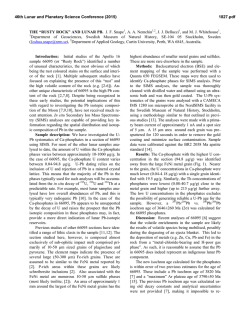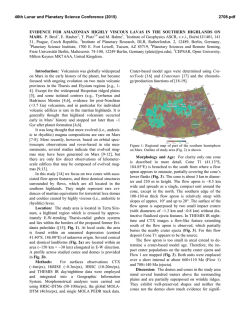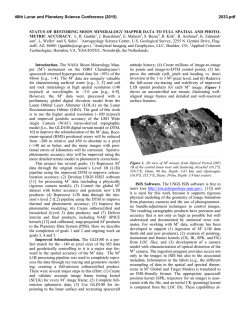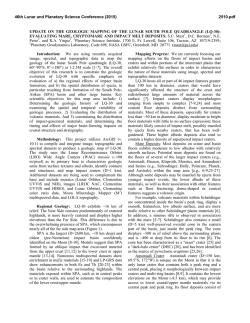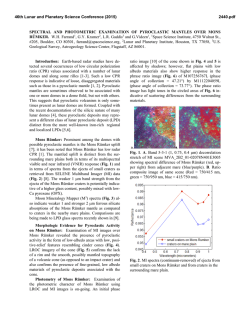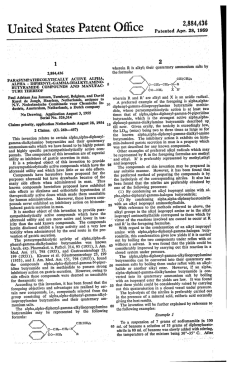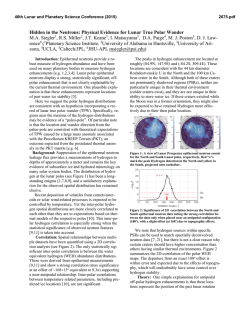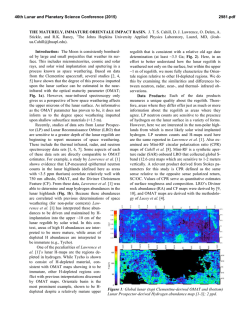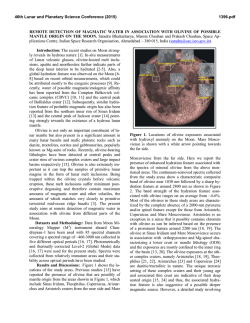
endogenic water/hydroxyl anomaly associated with lunar silicic
46th Lunar and Planetary Science Conference (2015) 1400.pdf ENDOGENIC WATER/HYDROXYL ANOMALY ASSOCIATED WITH LUNAR SILICIC DOMES DETECTED BY CHANDRAYAAN-I MOON MINERALOGY MAPPER (M3) INSTRUMENT AND ITS IMPLICATIONS. Sumit Pathak, Aurobindo Kumar Basantaray, Mamta Chauhan, Satadru Bhattacharya and Prakash Chauhan, Space Applications Centre, Indian Space Research Organisation, Ahmedabad – 380 015, India ([email protected]). Introduction: Silicic volcanism on the Moon is recorded as lunar redspots having high thorium concentration and characterized by steep slopes, high albedo, and strong absorption in the ultraviolet relative to visible region [e.g. 1, 2, 3]. These red spots are surface manifestations of more viscous and highly evolved rocks such as terrestrial rhyolites and dacites [e.g. 4, 5]. Recent detection of water and/or hydroxyl anomaly (OH/H2O) of endogenic/magmatic origin at three of such redspots, namely, Compton-Belkovich Volcanic Complex (CBVC) [6,7,8], Hansteen Alpha [7] and Gruithuisen Domes [7] based on Chandrayaan-1 Moon Mineralogy Mapper (M3) measurements would definitely enthuse many lunar scientists to search for similar enhanced hydroxylation features at other silicic domes that exist on the Moon. Bhattacharya et al. [7] has already presented a detailed study on strong hydroxylation of magmatic origin at CBVC and mentioned about the presence of weak to moderate hydration feature at Hansteen Alpha and Gruithuisen domes. Moreover, Bhattacharya et al. [7] has also reported for the first time, the presence of water/hydroxyl at CBVC and Hansteen Alpha with prominent spinel feature. Here we present a preliminary report on the nature of water/hydroxyl (OH/H2O) feature of possible magmatic/endogenic origin from Hansteen Alpha (α) and Gruithuisen Domes. Datasets: Global mode hyperspectral datasets from the Moon Mineralogy Mapper (M3) instrument aboard ISRO’s Chandrayaan-1, having 85 spectral channels between 460 to 3000 nm at a spatial resolution of ~140 m [9], have been used that are photometrically and thermally corrected [10]. Results: Hansteen alpha (11.5°S 50°W) and Gruithuisen domes (35.5°N 39°W) both occur on the near side of the Moon within the Procellarium KREEP Terrane (PKT) towards its southwestern and northwestern margin, respectively. Hansteen Alpha, is an arrow head prominent isolated domal feature with hackly texture and about 20-30 km across surrounded by mare basalts. Gruithuisen domes are characterized by group of circular to semicircular steep- sided relatively smooth domes [11, 12]. Both are characterized by their highly silicic nature as inferred through their compositional, morphological and rheological study carried by various researches [1114]. At Hansteen alpha, exposures of Mg-spinel have been reported recently in its silicic lithology [15]. Prominent hydration features have been observed in both Hansteen Alpha and Gruithuisen Domes. In Hansteen Alpha, the hydration feature is found to be associated with or without spinel [7], whereas in Gruithuisen Domes, it is found in association with spectra that lack any observable mafic silicate absorption feature. Spectra of hydration features as seen at the two study sites are presented in Figures 1 and 2 along with their respective pixel locations. The 2000-nm spinel feature at Hansteen alpha lacks any 1000-nm mafic feature [15]. The overall strength of the OH/H2O feature in Hansteen Alpha varies from ~4 – 8% having a mean value of ~5% while at Gruithuisen Domes its strength varies from ~3-7%. Discussions: Mg-spinel in association with non-mare silicic volcanism has only been reported so far from two areas on the Moon, namely, Hansteen Alpha [15] and CBVC [7]. Interestingly, in the both the cases, the 2000nm spinel feature is accompanied by a prominent hydroxyl feature at around 2800 nm [7]. Silicic magmas are highly differentiated and evolved products of their mafic parents and are thus enriched in volatiles [16]. The total water content (H2Ot) in the silicate melts remain in both molecular (H2Om) as well as hydroxyl (OH) form [17]. The dissolved water in silicates changes their physical and chemical properties as they can alter their structure, and thus plays a crucial role in volcanic eruptions and affects the evolution of magma [18]. On the Moon, during magma ocean crystallization, volatiles along with other incompatible trace elements became enriched in the magma ocean residuum, i.e., KREEP-rich lithologies, which are unique having as much as 1.4 wt% of water [19, 20]. Water upto 1% is soluble in basalt and rhyolite melts at modest pressures on the Moon (~1kbar or 2km depth) and therefore the evolved rocks are ideal for preserving H2O of their parent magmas and interior source region. [e.g., 21, 22] According to Jolliff et al. [23], the area with enhanced quantities of KREEP would be the obvious regions on the Moon that would contain the highest abundances of lunar indigenous water. As during the fractionation of the KREEP material, OH/H2O, being incompatible, gets enriched in the silicic melt. The observed hydroxyl (OH/H2O) feature at these non-mare silicic lithology indicate the presence of endogenic magmatic water and could therefore be related to the fractionation of KREEP, the residual LMO product, as both the areas have characteristically high thorium concentration. Laboratory based analytical studies and measurement of lunar volcanic glasses, apatite and anorthosites also suggests and supports that the Moon is not anhydrous [24, 25]. Enhanced hydration associated with endogenic water reported from the CBVC and from the central peaks of crater Bullialdus and Jackson strongly suggest the existence of a hydrous lunar mantle [26, 27]. Apart 46th Lunar and Planetary Science Conference (2015) Figure 1 from Bullialdus and Jackson crater central peaks, the presence of magmatic water has also been detected at the central peak of crater Theophilus in association with a varied lithology [28, 29]. Magmatic water has also been detected in association with olivine of possible mantle origin from the inner ring of Sinus Iridium [30]. This reporting of hydroxyl anomaly of endogenic nature associated with silicic lithology will add a new dimension to understand the lunar mantle and its hydrous nature. Figure 1. A. M3 image of Hansteen Alpha (Scene ID M3G20090418T190900) showing locations of spinelbearing and matured regolith-bearing pixels in red and green respectively. B. Normal and continuum-removed apparent reflectance spectra of spinel-bearing pixels shown in A (red pixels). Spinel spectra shows a moderate absorption feature near 2000 nm having average band depth of ~13% followed by a weak feature near 2800 nm (average band depth ~4%) indicative of the presence of OH/H2O in association with spinel-bearing regoliths at Hansteen Alpha. C. Normal and continuumremoved spectra of matured soil (green pixels in A) showing a prominent OH/H2O feature near 2800 nm having average band strength of ~4.5%. Figure 2. A. M3 (Scene ID M3G20090208T175211) RGB-FCC of Gruithuisen Domes (R: 930-nm M3 channel; G: 2018-nm M3 channel; B: 2816-nm M3 channel) showing locations of OH/H2O-bearing pixels marked by white arrows and colored boxes. B. Normal and continuum-removed apparent reflectance spectra of OH/H2Obearing pixels shown in A (red, green, blue, yellow and cyan pixels). Spectra lack 1000- and 2000-nm mafic features and show a prominent OH/H2O feature (indicated by a black dashed line) near 2800 nm having band strengths varying from ~3-7%. References: [1] Malin M. C. (1974) EPSL 21, 331– 341. [2] Head J. W. and McCord T. B. (1978) Science 199, 1433-1436. [3] Hawke B. R. et al. (2003) JGR. 108, E7, 5069. [4] Wilson L. and Head J. W. (2003) JGR 108, 5012. [5] Glotch T. D. et al. (2011) GRL 38, L21204. [6] Bhattacharya S. et al. (2013a) LPS XXXXIV, Abstract #1382. [7] Bhattacharya S. et al. (2013b) Curr. Sci. 105, 5, 685-691. [8] Petro N. et al. (2013) LPS XXXXIV, Abstract #2688. [9] Boardman, J. et al. (2011) JGR 116, E00G14. [10] Clark R. N. et. al. (2009) JGR 116, E00G16. [11] Hawke B. R. et al. (2003) JGR 108, E7, 5069. [12] Hawke B. R. et al. (2012) LPS XXXXIII, Abstract #1754. [13] Hagerty J. J. et al. (2006) JGR 111, E06002. [14] Glotch T. D. et al. (2010) Science 17, 329, 5998, 1510–1513. [15] Kaur P. et al. (2013) LPS XXXXIV, Abstract #1348 [16] Elkins-Tanton (2011) EPSL 305, 1-10. [17] Stopler (1982) Geochim. Cosmochim. Acta 46, 2609–2620. [18] Zhang (1999) Rev. Geophys. 37, 4, 493-516. [19] Shearer C. K. et al. (2006) Rev. Min. Geochem. 60, 365-518. [20] Warren P. H. (1979) LPS X, 1301-1303. [21] Newman and Lowenstern (2002) Comp. and Geosci. 28, 597-604. [22] 1400.pdf Robinson M. et al. (2012) LPS XXXXIII, Abstract #1727. [23] Jolliff B. L. et al. (2000) JGR 105, 4197–4216. [24] Hauri E. H. et al. (2011) Science 333, 6039, 213-215. [25] Saal A. E. et al. (2008) Nature 454, 192–195. [26] Klima R. et al. (2013) Nat. Geosci. doi:10.1038/ngeo1909. [27] Chauhan P. et al. (2014) LPS XXXXV, Abstract #2072. [28] Lal, D., et al., (In Review) Icarus (M/S Ref. No.: ICARUS-13828). [29] Bhattacharya S. et al., this volume. [30] Bhattacharya S. et al. (2014) LPS XXXXV, Abstract #1816. 1 Figure 3 2
© Copyright 2025

